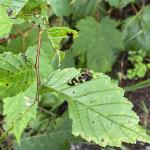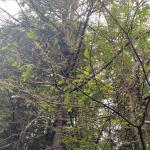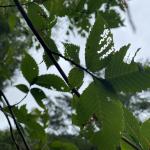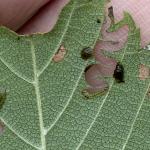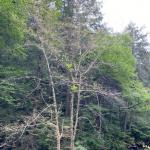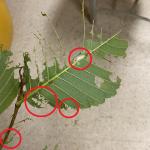Elm Zigzag Sawfly
Order: Hymenoptera
Family: Argidae
Aproceros leucopoda
Overview
The elm zigzag sawfly (Aproceros leucopoda) is a nonnative insect that originated in eastern Asia (Japan and certain regions of China). It is now invasive in Europe (2003) and North America. The elm zigzag sawfly has been found in Virginia (2021), Maryland, Pennsylvania, North Carolina, New York, and Vermont. In 2023, the elm zigzag sawfly was first detected in a small, forested area of Berkshire and Hampden Counties in Massachusetts: https://www.mass.gov/news/dcr-announces-that-elm-zigzag-sawfly-has-been-confirmed-in-massachusetts . Significant defoliation of elm host plants was seen at the impacted locations. It is currently unclear how widespread the elm zigzag sawfly is in Massachusetts, or how the infestation was introduced. If you suspect you have found elm zigzag sawfly in Massachusetts, please report it here: https://survey123.arcgis.com/share/e8fc855a19884c01b2796481ebeac9d8 .
Host Plants
As the common name suggests, the caterpillars of the elm zigzag sawfly feed on elm (Ulmus spp.). They may commonly feed on slippery elm (Ulmus rubra), winged elm (Ulmus alata), American elm (Ulmus americana), siberian elm (Ulmus pumila), English elm (Ulmus minor 'Atinia'), lacebark elm (Ulmus parvifolia), and hybrid elms (Ulmus spp.). (Hybrids found to be impacted in Virginia include: Ulmus ‘Cathedral’ Japanese x Siberian hybrid.) Elms in both natural/forested areas as well as managed landscapes are fed upon by this insect.
Identification/Life Cycle
Elm zigzag sawfly caterpillars are pale green with a black stripe on their heads and dark T-shaped markings on their legs. The larvae are small and can easily blend into the leaf, it may require close inspection to find. While they resemble the caterpillars of butterflies and moths, they are not. Sawflies are more closely related to the ants, bees, and wasps and their adults resemble a wasp with a broad waist. Adults are 6-7 mm. long, shiny and black, with pale yellow legs and darkly colored wings. The adult sawflies do not sting humans. Once the caterpillar is fully mature (10-11 mm. long) and ready to pupate, they spin a silken, net-like case around themselves. Pupae may change in color as they mature, from pale green to dark. Pupal cases are often found on host plant leaves, on the ground below, or on nearby objects. Thus far, no adult male zigzag sawflies have been found. The entire population is female, and parthenogenetic - able to lay viable eggs without fertilization from a male. Two generations per year are known to occur in North Carolina and Virginia, however in Europe, 4-6 generations per year are possible.
Elm zigzag sawfly overwinters in the pupal life stage, and adult females emerge as temperatures warm in the spring. As host plant foliage becomes available, females lay unfertilized eggs in tiny notches on the edges of leaves. Each female lives for approximately 1-6 days and lays up to 60 eggs (a range of 7-49 eggs per female has been reported). Eggs are tiny, and approximately 0.8-1.0 mm. long when laid. Eggs are blue-green in color when first laid, but turn black just prior to hatching. Egg hatch can occur in approximately 4-8 days. Caterpillars feed for 15-18 days prior to pupation, and pass through 6 instars. Caterpillars possess 3 pairs of hardened thoracic legs and 6 pairs of fleshy abdominal prolegs. The dark, T-shaped markings occur on the second and third pair of the hardened thoracic legs. Pupae in the summer months (if there are multiple generations per year) are in loosely woven nets, often attached to leaves. If leaves are not available, they may be attached to other nearby objects, including fence posts. Pupae destined to overwinter are often formed in the leaf litter or soil nearby the host plant, and are denser with solid walls. Adults that emerge from non-overwintering pupae can do so in approximately 10 days. In Europe, it is estimated that a full generation of these sawflies can occur in less than 1 month.
Damage
Females cause a tiny amount of damage to the edges of host plant leaves as they lay their eggs. Tiny scars are formed as a result of female egg laying. Eggs hatch, and young sawfly caterpillars begin their characteristic zig-zag patterned feeding. These zig-zag shaped notches in the leaf can extend 5-10 mm into the leaf from the edge. Multiple caterpillars can feed on a single leaf. Entire leaves can be completely defoliated, leaving only veins behind. Heavily infested trees can suffer partial or complete defoliation. It is currently thought that elms can recover from periodic defoliation by this pest, however individual elm trees may be weakened and predisposed to other pests and stressors by elm zigzag sawfly feeding. If several years of complete defoliation occur in a row, tree mortality could possibly occur, however this has not yet been observed in the US. Death of individual branches on susceptible hosts has been observed. The impact of this new invasive insect in the United States is not currently fully understood. In Europe, it is common that the elm zigzag sawfly outbreaks regularly and defoliates urban trees and large tracts of natural forest, however mortality of entire trees has not been reported there. Some trees are known to create new foliage following defoliation in a single season.
Management Strategies:
Elm zigzag sawfly is new to the United States and management strategies are still being determined. Additionally, chemical management options including products that may be effective at managing sawflies are not yet specifically labeled for use against the elm zigzag sawfly. The most important and first management step at this time is to report elm zigzag sawfly, if found in Massachusetts, here: https://survey123.arcgis.com/share/e8fc855a19884c01b2796481ebeac9d8 . Take photos and note your exact location. Do not move infested host plants from the area.
Cultural/Mechanical Management:
Small populations on individual trees may be managed by picking sawflies off by hand and dropping them into a bucket of soapy water or crushing them. Spraying the sawflies off individual trees with a strong stream of water from a hose may also interrupt their feeding. On larger trees or plantings, this may not be practical. Prevent spreading this insect in Massachusetts by avoiding accidental transport of the life stages of the insect or infested plant material. Pupae can be removed and destroyed if found.
Biological Control/Natural Enemies:
Biological control agents of the elm zigzag sawfly or potentially significant natural enemies of this insect in North America are currently not fully understood or available.
Potential natural enemies of the elm zigzag sawfly in Canada are unknown. In Romania, Itoplectis maculator and Pimpla turionellae are two ichneumonid parasitoid wasps that parasitize elm zigzag sawfly caterpillars, but whose adults emerge from the pupae of the sawfly (Constantineanu and Constantineanu, 2018). Also in Romania, an eulophid wasp egg parasitoid of the elm zigzag sawfly, Asecodes erxias, is also known. In eastern Asia, a tachinid parasitoid of the elm zigzag sawfly is known, Blondelia nigripes. In Serbia, the multicolored Asian lady beetle, Harmonia axyridis, which is also present in Massachusetts, is a known predator of the elm zigzag sawfly. It is unclear at this time what the impact of Harmonia axyridis feeding on elm zigzag sawfly in Massachusetts will be.
Chemical Management:
Chemical management of the elm zigzag sawfly should target young, feeding larvae as soon as they are present in the spring. In Europe, chemical management of this insect has proved difficult, due to the ability of subsequent multiple generations to reinvade treated trees. Research on the efficacy of chemical management of the elm zigzag sawfly in North America is limited.
With large ornamental plantings or thoroughly infested plants, chemical management options to treat elm zigzag sawfly may be practical. Integrated Pest Management (IPM) strategies to reduce dependency on chemical insecticides and protect the health of the applicator and the environment are encouraged. When possible, choose the lowest risk active ingredient to manage any insect pest.
Homeowners in areas of Massachusetts where elm zigzag sawfly has become established may need to hire a professional, licensed pesticide applicator to help with chemical management. Elm zigzag sawfly is present in a small area of Massachusetts. Chemical management in areas of the state where this insect has not been confirmed to exist is unnecessary at this time.
Some active ingredients that may be used to manage sawfly caterpillars, such as the elm zigzag sawfly, include but are not limited to:
Acephate (NL) (systemic insecticide, injection)
Azadirachtin (larva only) (NL) (systemic insecticide, injection, soil drench)
Bifenthrin (NL) (contact insecticide)
Bifenthrin+imidacloprid (L) (contact insecticide)
Carbaryl (L) (contact insecticide)
*Chlorpyrifos (N) (contact insecticide)
Cyfluthrin (larva only) (NL) (contact insecticide)
Deltamethrin (larva only) (L) (contact insecticide)
Dinotefuran (larva only) (NL) (systemic insecticide, soil drench)
Emamectin benzoate (L) (systemic insecticide, injection)
Flonicamid+cyclaniliprole (N) (contact insecticide)
Gamma-cyhalothrin (L) (contact insecticide)
Horticultural oil (larva only) (L) (contact insecticide)
Imidacloprid (larva only) (L) (systemic insecticide, soil drench)
Insecticidal soap (larva only) (NL) (contact insecticide)
Lambda-cyhalothrin (L) (contact insecticide)
Pyrethrin+sulfur (larva only) (NL) (contact insecticide)
Spinetoram+sulfoxaflor (larva only) (N) (contact insecticide)
Spinosad (larva only) (NL) (contact insecticide)
*When used in nurseries, chlorpyrifos is for quarantine use only.
Read and follow all label instructions for safety and proper use. If this information contradicts language on the label, follow the most up-to-date instructions on the product label. Always confirm that the site you wish to treat and the pest you wish to manage are on the label before using any pesticide. Active ingredients labeled "L" indicate some products containing the active ingredient are labeled for landscape uses on trees or shrubs. Active ingredients labeled "N" indicate some products containing the active ingredient are labeled for use in nurseries. Always confirm allowable uses on product labels. This active ingredient list is based on what was registered for use in Massachusetts at the time of publication. This information changes rapidly and may not be up to date. If you are viewing this information from another state, check with your local Extension Service and State Pesticide Program for local uses and regulations.
References
-
This sawfly is zigzagging its way across elm leaves, Natural Resources Canada
-
Here We Go Again: Meet the Elm Zigzag Sawfly, Another Non-Native Forest Pest, Entomology Today
Authors
Tawny Simisky, Entomologist, UMass Extension
Nicole Keleher, Massachusetts Department of Conservation and Recreation, Forest Health Program
